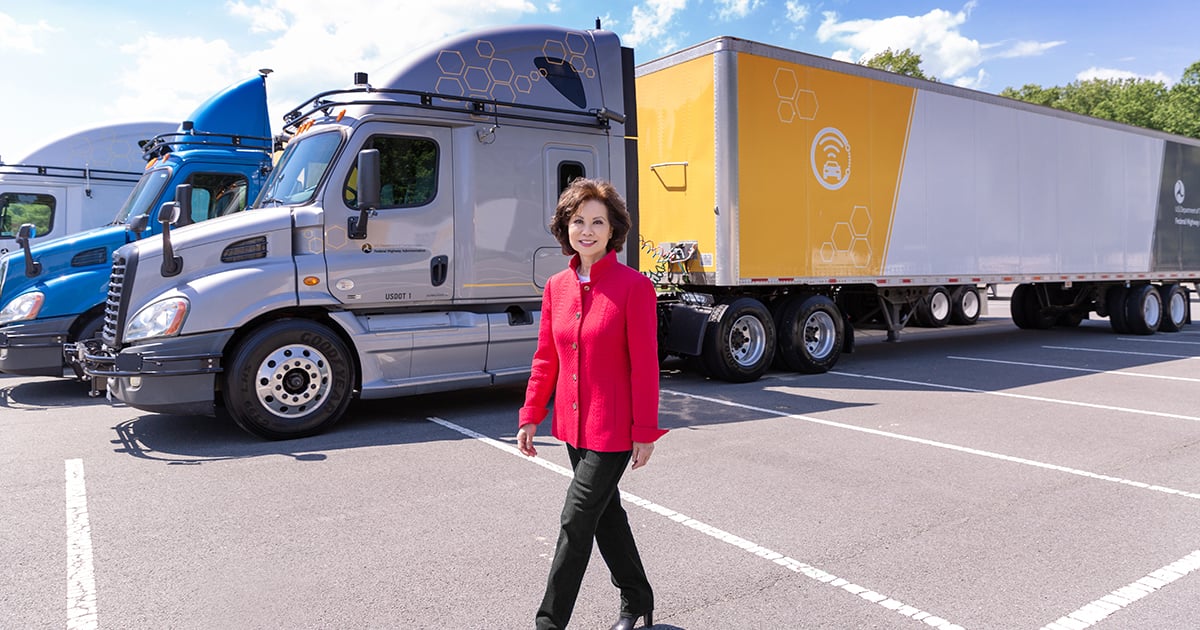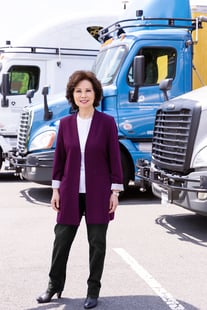A Conversation with U.S. Secretary of Transportation Elaine Chao
by Michele Wade, on Aug 25, 2020 11:29:47 AM

As Secretary of the U.S. Department of Transportation, Elaine Chao plays a vital role in shaping the industry. She oversees the formulation of national transportation policy and serves as principle advisor to the president in all matters relating to federal transportation programs. Redefining the Road magazine recently caught up with Secretary Chao to talk about her personal career journey, her perspective on gender diversity and her insights on the industry today.
RTR: What inspired you to begin working in the transportation industry?
EC: Transportation has been a big part of my life. I immigrated to the United States on a cargo ship when I was eight years old, not speaking any English. When we settled in this country, my family and I learned about America through family road trips on our national highway network. I never could have imagined then the opportunities that America would hold for my family and me.
My first job out of business school was working as a transportation banker. Then, I began my career in public service working on transportation issues at the White House. I went on to serve as Deputy Maritime Administrator at the U.S. Department of Transportation, Chairman of the Federal Maritime Commission, and Deputy Secretary of the U.S. Department of Transportation (DOT).
I have always been grateful for the trust and confidence people have had in me to give me a job. In each position, I’ve been propelled by a desire to learn, a wish to do good, and the ability to have a positive impact. The fact that transportation systems connect people and provide access to needed goods and services has always resonated with me.
RTR: What have been the greatest challenges you faced in entering and rising through the ranks?
EC: Among the challenges I faced as a young staffer, was mastering the subject at hand, as well as learning to speak up and be taken seriously in meetings. Having a mastery of the subject matter gave me a better chance to “command the floor,” so to speak.
Women were something of a novelty in the upper levels of government and the private and nonprofit sectors at the time. Asian-American women were rarer still. I worked very hard. Each day, I tried to do what was asked of me with enthusiasm and resourcefulness. It’s been my experience that if you do a good job, people take notice. The transportation sector is still very male-dominated today. I’ve always been a strong advocate for more inclusion of women and other under-represented communities in this sector.
RTR: Why do you think it’s important to incorporate more gender diversity in our industry?
EC: Today, more and more women are leading the way in some of our nation’s top industries, including transportation. At the U.S. DOT, we’re proud that nearly 160 women occupy senior executive positions throughout the Department and the modes. But women are still substantially underrepresented in the trucking industry. Data from the Women In Trucking Association indicates that women account for just 10.2 percent of the trucking workforce. The Federal Motor Carrier Safety Administration is committed to exploring new ways to recruit and support women behind the wheel of our trucks and buses. A diverse workforce, at every level, will benefit the entire industry.
RTR: Given your experience and background, what advice would you share with women interested in pursuing transportation careers?
EC: Go for it! Transportation is the lifeblood of our economy. Transportation systems connect people and provide access to much needed goods and services. It’s an exciting sector! Truckers play a critical role in keeping the supply chain open – and that’s never been more evident than in the wake of COVID-19. We have all seen the contributions that truckers make each day to support our economy in delivering needed goods and supplies all across America. I hope that the examples of these American heroes inspire the next generation of women to pursue careers in the transportation field.
RTR: How would you encourage women who are considering starting a business in the industry?
EC: My single biggest piece of advice is to never give up. America is truly the land of opportunity and entrepreneurial spirit. As with any new enterprise, you need a solid business plan, a good accountant, and – as your business expands – to surround yourself with talented people who share your passion and commitment. With hard work, determination and tenacity, good things will happen.
At the U.S. DOT, we’re committed to creating ladders of opportunity for women-owned businesses. In fiscal year (FY) 2018, we awarded more than 9 percent of contracts to women-owned small businesses. In addition, during FY2018, the Disadvantaged Business Enterprise program helped ensure that women-owned small businesses won a share of contracts awarded to firms working with recipients of Federal Aviation, Highway and Transit Administration funds. They won 54 percent of these federally assisted contracts, for a total amount of more than $2.5 billion.
 RTR: How would you recommend transportation companies recruit and retain more women into the industry?
RTR: How would you recommend transportation companies recruit and retain more women into the industry?
EC: Bringing more women into the workforce benefits organizations. It makes no sense to be recruiting from only half the population. Companies should recruit on campus, obviously, and from women-centric industry associations. The military and veterans’ organizations are a tremendous source of educated, skilled, disciplined and goal-oriented women.
I’m very proud to have many senior women leaders on our team at the U.S. DOT. We continue to pay it forward by investing in the next generation of women leaders. Through the Department’s Women & Girls in Transportation Initiative (WITI), we offer internship opportunities to help young women enter the transportation sector. To learn more about this initiative, visit transportation.gov/osdbu/women-and-girls.
RTR: You often say that safety is your number one priority. How is the DOT helping to increase safety and reduce crashes involving large trucks on America’s roadways?
EC: Safety factors into everything the U.S. DOT and the FMCSA do. We regularly work with truck drivers and industry leaders to enhance driver safety and accident prevention. During this Administration, FMCSA has done a historic update to hours-of-service rules to improve safety and increase flexibility for commercial drivers. These important changes will allow truck drivers more options during the workday and improve safety on our roadways.
In 2019, FMCSA awarded $77.3 million in grants to states and educational institutions to enhance commercial motor vehicle safety. FMCSA’s Our Roads, Our Safety partnership has grown to 27 partner organizations across industry, safety, and driver education stakeholders. We’re especially proud that the Women In Trucking Association plays a key part in this initiative.
The Agency also recently released its Voices of Safety campaign—a video series and national public awareness campaign designed to raise awareness among all road users about sharing the road safely with large trucks and buses. The 2019 public awareness campaign achieved more than 359 million views in markets and platforms across the nation.
RTR: Do you anticipate changes to DOT policy and/or practices in the trucking industry in the wake of COVID-19?
EC: As we’ve seen when regional natural disasters strike, it’s America’s truck drivers who bring needed groceries to restock store shelves and lifesaving medical supplies to hospitals. Commercial drivers have played a key role in keeping America’s supply chain moving.
Truckers will play an equally important part as our economy re-opens and resumes its strong growth. That’s why FMCSA issued a first-of-its-kind national emergency declaration to provide hours-of-service regulatory relief for those transporting emergency relief in response to COVID-19. This allows drivers to deliver packages and products more efficiently during this time of need.
In addition, the Agency has worked closely with state licensing agencies and provided important regulatory waivers so that individuals who are seeking commercial learner’s permits and licenses can still receive them. We’ve also taken action to help ensure that truck stops and state rest stops are open and provide food for truckers.
This article was originally featured in Edition 2 of 2020 in our official magazine, Redefining The Road.
Like this kind of content? As a member of the Women In Trucking Association, stay on top of emerging trends and business issues impacting transportation, logistics, and supply chain operations, learn the importance of gender diversity in the workplace and the need for more women drivers, and see best practices in encouraging the employment of women in the trucking industry. Learn More





